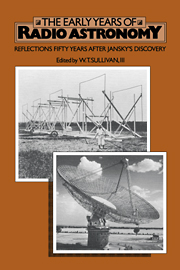Book contents
- Frontmatter
- Contents
- Preface
- THE EARLIEST YEARS
- AUSTRALIA
- ENGLAND
- The origins and early history of Jodrell Bank
- Paraboloids, galaxies and stars: memories of Jodrell Bank
- Early work on radio stars at Cambridge
- The development of aperture synthesis at Cambridge
- THE REST OF THE WORLD
- BROADER REFLECTIONS
- Biographical notes on contributors
- Name index
- Subject index
The origins and early history of Jodrell Bank
Published online by Cambridge University Press: 05 March 2010
- Frontmatter
- Contents
- Preface
- THE EARLIEST YEARS
- AUSTRALIA
- ENGLAND
- The origins and early history of Jodrell Bank
- Paraboloids, galaxies and stars: memories of Jodrell Bank
- Early work on radio stars at Cambridge
- The development of aperture synthesis at Cambridge
- THE REST OF THE WORLD
- BROADER REFLECTIONS
- Biographical notes on contributors
- Name index
- Subject index
Summary
WORLD WAR II INFLUENCES
The observatory at Jodrell Bank emerged in a most unusual manner from my research work as a young man on cosmic rays. In the years immediately before the outbreak of World War II, I was on the staff of the Physics Department of the University of Manchester as an Assistant Lecturer. Originally I continued my researches on the electrical conductivity of thin films, which I had worked on as a postgraduate student in Bristol, but when P.M.S. Blackett succeeded W.L. Bragg as the Professor of Physics in 1937 I eagerly seized the opportunity of joining him in his cosmic ray researches. I took over from a young Chinese, Hu Chien Shan (who had returned to China to help in the war against Japan), and modernised an automatic counter-controlled cloud chamber. With this device I first studied the cosmic ray showers produced by the newly discovered particles, the ‘heavy’ electrons, then called mesotrons, later mesons and now recognised as the mu-meson or muon. With L. Jánossy (Jánossy & Lovell 1938) and J.G. Wilson (Lovell & Wilson 1939) I was using this device to investigate the extensive cosmic ray air showers in 1939. In the later stages of this work we were using two cloud chambers separated by 20 metres to photograph showers which we estimated to have energies approaching 1016 eV.
At that time the energy spectrum had been established only to about 1010 eV, and there was little information about the spectrum at higher energies or about the upper limit of the energy range.
- Type
- Chapter
- Information
- The Early Years of Radio AstronomyReflections Fifty Years after Jansky's Discovery, pp. 193 - 212Publisher: Cambridge University PressPrint publication year: 1984
- 4
- Cited by



